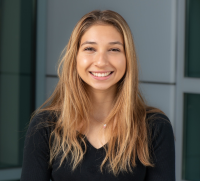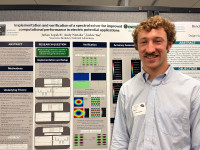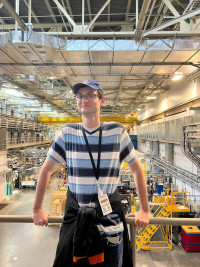SULI Program Helps Computing Sciences Area Summer Interns Break New Ground
August 31, 2023
By Keri Troutman
Contact: cscomms@lbl.gov
Summer interns are a win-win for Andy Nonaka, staff scientist and group lead of the Center for Computational Sciences and Engineering (CCSE) at Lawrence Berkeley National Laboratory (Berkeley Lab). “The students bring so much life and energy into our division, and likewise give myself and other colleagues a chance to work on projects that we haven’t necessarily had the bandwidth to focus on.”
Nonaka hosted three of six Science Undergraduate Laboratory Internship (SULI) interns in Berkeley Lab’s Computing Sciences Area this summer. The DOE SULI program is designed to encourage undergraduate students from two- and four-year colleges, post-baccalaureates, and graduate students to pursue science, technology, engineering, and mathematics (STEM) careers by providing research internships at one of 17 DOE national laboratories.
“The SULI program exists to prepare the next generation of scientists and STEM professionals and allow them to really plug in and become part of the future of the DOE mission,” said Colette Flood, Lab Education Director for the Department of Energy Office of Science, Workforce Development for Teachers and Scientists programs and Director of Berkeley Lab’s Workforce Development & Education (WD&E).
“Berkeley Lab is a great place to offer this program, because there are so many possible projects for interns to work on,” said Laleh Coté, STEM Education Specialist in WD&E.
Aside from their project mentors, WD&E recruits guest speakers and tour guides from across the Lab to interact with the interns. “From years of collecting data, we know that interns contribute to the STEM community by entering careers in research, policy, education, and starting their own companies! So, during the internships, we make sure to bring them into contact with people from different Divisions, to highlight a variety of career pathways,” said Coté.
This summer WD&E hosted a much larger group of interns than usual, and it was the first fully in-person cohort since pre-COVID. “There’s a real community among our interns,” said Flood. “With weekly meetings and peer-to-peer mentoring, they really become part of the Lab.”
Here are some of the students who came to Berkeley Lab this summer through the SULI program.
Ifrah Khurram
 Ifrah Khurram, who will be starting her second year of medical school at San Juan Bautista School of Medicine this fall, is especially interested in the intersection between computing and healthcare. “I want to be a physician who has a comprehensive understanding of the technology in patient care so that I can formulate the best treatment plan and provide my patients benefits from constant healthcare innovations,” said Khurram. She joined the SULI program this summer to work with Computational Biologist Silvia Crivelli’s team in Berkeley Lab’s Applied Mathematics and Computational Research Division on a project focused on obstructive sleep apnea (OSA).
Ifrah Khurram, who will be starting her second year of medical school at San Juan Bautista School of Medicine this fall, is especially interested in the intersection between computing and healthcare. “I want to be a physician who has a comprehensive understanding of the technology in patient care so that I can formulate the best treatment plan and provide my patients benefits from constant healthcare innovations,” said Khurram. She joined the SULI program this summer to work with Computational Biologist Silvia Crivelli’s team in Berkeley Lab’s Applied Mathematics and Computational Research Division on a project focused on obstructive sleep apnea (OSA).
Obstructive sleep apnea affects millions of patients and is linked to severe illnesses such as heart failure and stroke. Expensive continuous positive airway pressure (CPAP) machines can be used to prevent these comorbidities. However, an understanding of who will develop these comorbidities and can benefit from using these machines is lacking. Large language models (LLMs) – trained on vast amounts of data – are promising tools to discriminate OSA-related phenotypes.
“Ifrah’s research has explored different LLMs and can provide valuable insights for allocating CPAP treatment effectively by grouping patients with similar health histories and OSA outcomes,” said Crivelli. “She showed that the specific models such as Gatortron and BioGPT produced the best results for her preliminary study using a relatively small dataset and we are very excited about applying her findings to a much larger dataset.”
“In the short time span of less than 10 weeks, I have made progress and have results to share,” said Khurram. “A major part of this is due to the mentorship and guidance I have found at Berkeley Lab as well as the company of like-minded individuals who work alongside me.”
Iliana Marrujo
 Iliana Marrujo, who just graduated from the University of California, Los Angeles and will begin her Ph.D. in materials science and engineering at UC Berkeley this fall, returned to Berkeley Lab for a second summer, this time through the SULI program. Marrujo loved her experience at the Lab last summer and wanted to continue to learn and expand her skills as a researcher.
Iliana Marrujo, who just graduated from the University of California, Los Angeles and will begin her Ph.D. in materials science and engineering at UC Berkeley this fall, returned to Berkeley Lab for a second summer, this time through the SULI program. Marrujo loved her experience at the Lab last summer and wanted to continue to learn and expand her skills as a researcher.
Marrujo’s work, under the supervision of Nonaka and and mentors Daniel Ladiges and Ishan Srivastava, focused on a fundamental scientific investigation of how turbulence in compressible gasses behaves at nanoscales. Using fluctuating hydrodynamics codes that run on Berkeley Lab supercomputers, Marrujo ran models to examine the nature of how these flows transfer energy from larger scales to smaller scales.
She also researched quantum circuit design and how thermal fluctuations can interfere with performance. Marrujo ran a suite of simulations to gather statistics on the best way to keep phonons from interfering with the functionality of the quantum chips.
“SULI has given me the opportunity to continue my research and develop new perspectives for addressing complex problems,” said Marrujo.
Julian LePelch
 Julian LePelch, who recently graduated with a math degree from UC Santa Cruz, joined the SULI program this summer to help Berkeley Lab’s CCSE group with microelectronics simulations, under the mentorship of Nonaka and Jackie Yao.
Julian LePelch, who recently graduated with a math degree from UC Santa Cruz, joined the SULI program this summer to help Berkeley Lab’s CCSE group with microelectronics simulations, under the mentorship of Nonaka and Jackie Yao.
“We believe that by leveraging magnetic materials we can make much lower-energy electronics, but so far it is largely in the proof of concept stage and not prevalent in commercial microelectronics,” said Nonaka. “There are numerical modules in our code that compute how electromagnetic fields interact with magnetic materials, and Julian is developing codes to validate these theories.”
“I have implemented and validated a spectral solver in the AMReX software framework, which has significantly improved the computational performance of computing electric fields given a charge distribution,” said LePelch. “I am also in the process of modifying this algorithm to work in another exascale framework called MagneX, where we solve a similar system with open boundary conditions to find demagnetization.”
LePelch said he credits his SULI summer experience with helping him discover research opportunities and career options in the field of computational mathematics, as well as developing his collaboration, technical math, and programming skills.
Jordan Lees
 Jordan Lees, who graduated this spring from Rowan University with a degree in electrical and computer engineering, joined the SULI program at Berkeley Lab this summer and had a chance to delve into computer architecture. Working under John Shalf in Berkeley Lab’s Applied Mathematics and Computational Research Division, Lees learned to use Chisel, a new open-source hardware construction language developed at UC Berkeley that supports advanced hardware. Lees’ work was focused on creating a way for processors on a multi-core system to directly communicate with each other, to improve workload performance.
Jordan Lees, who graduated this spring from Rowan University with a degree in electrical and computer engineering, joined the SULI program at Berkeley Lab this summer and had a chance to delve into computer architecture. Working under John Shalf in Berkeley Lab’s Applied Mathematics and Computational Research Division, Lees learned to use Chisel, a new open-source hardware construction language developed at UC Berkeley that supports advanced hardware. Lees’ work was focused on creating a way for processors on a multi-core system to directly communicate with each other, to improve workload performance.
“The SULI internship has been great, as it gave me the opportunity to learn more about these tools and to be surrounded by people who are similarly interested in computer architecture,” said Lees.
About Berkeley Lab
Founded in 1931 on the belief that the biggest scientific challenges are best addressed by teams, Lawrence Berkeley National Laboratory and its scientists have been recognized with 16 Nobel Prizes. Today, Berkeley Lab researchers develop sustainable energy and environmental solutions, create useful new materials, advance the frontiers of computing, and probe the mysteries of life, matter, and the universe. Scientists from around the world rely on the Lab’s facilities for their own discovery science. Berkeley Lab is a multiprogram national laboratory, managed by the University of California for the U.S. Department of Energy’s Office of Science.
DOE’s Office of Science is the single largest supporter of basic research in the physical sciences in the United States, and is working to address some of the most pressing challenges of our time. For more information, please visit energy.gov/science.









